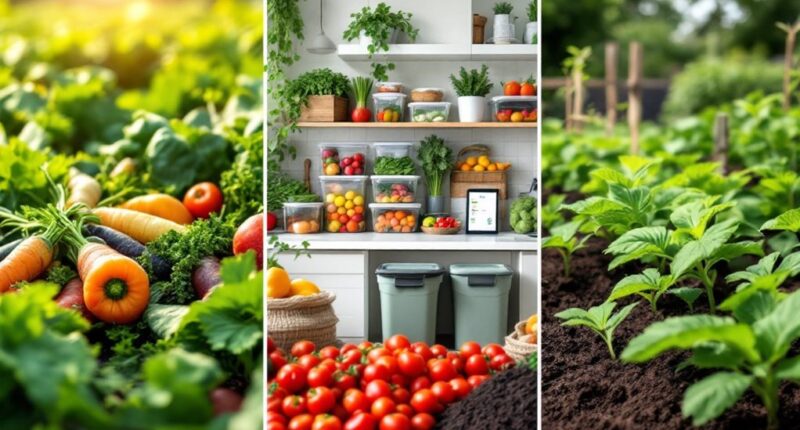Food waste reduction requires an extensive approach spanning the entire supply chain. AI-powered kitchen systems track waste, while food rescue apps connect surplus with those in need. Clearer date labeling helps consumers make informed decisions, potentially saving families $3,000 annually. Sustainable farming produces longer-lasting food, and composting transforms inevitable scraps into valuable resources. From tech innovations to community education, these interconnected solutions create a more sustainable food system with benefits for both wallets and the planet.

While mountains of perfectly edible food pile up in landfills each day, innovative solutions to combat this global challenge are emerging across every stage of the food supply chain. From sophisticated AI systems to simple storage improvements, these interventions are transforming how we value what’s on our plates – and what might otherwise be tossed.
In commercial kitchens, where 5-15% of food purchases typically end up discarded, AI-powered cameras and scales have become the eagle-eyed accountants of waste management. These systems track every scrap in seconds, turning garbage into gold mines of operational insight. It’s like having a tiny efficiency expert perched on the edge of every trash can, whispering “Are you sure about that?”
The humble refrigerator has gotten a high-tech makeover too. IoT sensors now monitor produce freshness with the attentiveness of helicopter parents, while blockchain technology illuminates supply chains that were previously murkier than week-old stew. Smart fridges can even peer at their contents and suggest recipes – fundamentally saying, “I see you’ve forgotten about that broccoli for five days; perhaps a soup is in order?” Sustainable farming practices further upstream help reduce waste by producing food with longer shelf life and better resilience to transportation challenges.
Connecting excess with need has never been easier. Food rescue apps match surplus food with hunger relief organizations faster than a dating app pairs compatible singles. These platforms are supported by liability protection laws that encourage businesses to donate rather than discard – removing the “what if” anxieties that previously sent good food to landfills. Gleaning programs collect excess food from farms and markets, helping reduce waste while feeding those in need.
For consumers bewildered by cryptic “best by” labels (is that yogurt expired or just being dramatic?), standardized date labeling initiatives are bringing clarity. Families can save approximately over $3,000 yearly by making more informed decisions about their food and reducing household waste. Meanwhile, municipal composting programs are transforming inedible scraps into garden gold, giving banana peels a dignified afterlife as soil.
The most promising approach combines technological innovation with common sense. By improving on-farm storage, accepting “ugly” produce, planning meals thoughtfully, and treating leftovers as ingredients rather than inconveniences, we’re slowly rewriting our relationship with food.
In this evolving story, waste isn’t inevitable – it’s simply an opportunity we haven’t seized yet.
Frequently Asked Questions
How Does Income Level Impact Food Waste Behavior?
Income level greatly impacts food waste behaviors across households.
Higher-income families typically waste more food, lacking financial incentives to conserve and purchasing more perishables than they consume. Conversely, lower-income households waste less food due to budget constraints, carefully planning purchases to maximize limited resources.
Curiously, higher-income Americans are less likely to connect food waste with climate change, while lower-income individuals tend to be more conscious of environmental impacts from their consumption patterns.
Can AI Technology Help Predict Food Waste Patterns?
AI technology has proven remarkably effective at predicting food waste patterns. By analyzing historical data, seasonal trends, and even weather patterns, AI systems can forecast customer behavior with impressive accuracy.
Machine learning algorithms can identify waste hotspots and optimize supply chains, reducing waste by up to 50% in food service operations. These smart systems don’t just track waste—they anticipate it, allowing businesses to adjust ordering, implement dynamic pricing strategies, and ultimately prevent perfectly good food from ending up in landfills.
What Role Do Cultural Attitudes Play in Food Waste?
Cultural attitudes greatly influence food waste behaviors across societies. Some cultures emphasize waste minimization, while others intentionally leave food as offerings.
Religious beliefs can both discourage waste and promote ceremonial food abundance. Curiously, a disconnect often exists between values and actions, with most people believing they waste less than others.
Regional differences are notable: Mediterranean consumers actively judge food edibility while American culture prioritizes quantity over quality, contributing to higher waste levels.
How Does Weather Affect Agricultural Food Waste?
Weather greatly impacts agricultural food waste through multiple channels.
Extreme events like floods and droughts damage crops before harvest, while unpredictable patterns disrupt planting and harvesting schedules. Sudden temperature changes can accelerate ripening, overwhelming processing capacities.
Heavy rainfall affects transportation infrastructure, delaying distribution and causing spoilage. Climate variability also impacts storage conditions, reducing shelf life.
These weather-related losses occur at various points in the supply chain, from field to distribution centers, creating substantial waste challenges for farmers.
Are Food Waste Reduction Efforts Economically Viable for Small Businesses?
Food waste reduction efforts offer compelling economics for small businesses.
With restaurants saving $7 for every $1 invested and some food-related businesses experiencing up to 14-fold ROI, the numbers speak for themselves.
Practical strategies like demand forecasting, cross-utilization of ingredients, and proper staff training require minimal investment while delivering significant returns.
Government programs further sweeten the deal with low-cost loans, tax incentives, and liability protections for food donations, making sustainability financially sensible.









